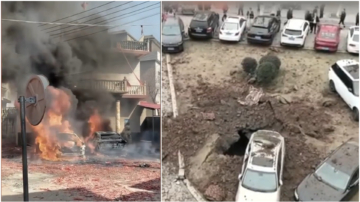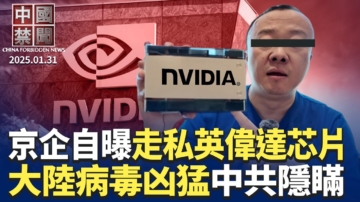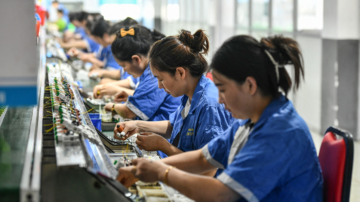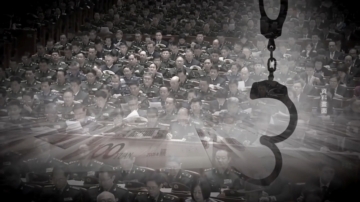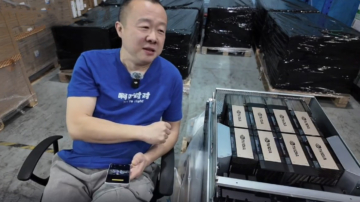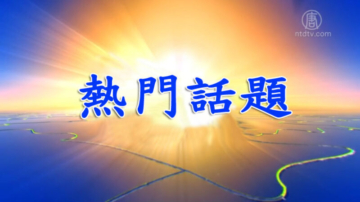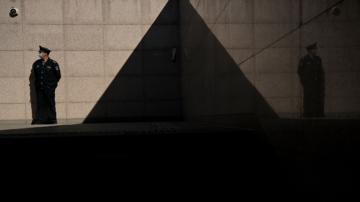【新唐人2014年11月14日訊】在北京召開的APEC峰會已經落幕,給人們印象最為深刻的,不是那奢華無比的會議區,也不是迎接各國首腦的龐大陣容,而是北京天空那難得一見的藍天。對此,民間戲言道:APEC藍。雖然它的出現是短暫的,但中國為此付出的代價,和將要承受的負面影響,卻是難以想像的巨大。
隨著亞太經濟合作組織(APEC)峰會的結束,中共在會議期間不惜代價打造的藍天——APEC藍,也隨之「聞名世界」,不僅在網路熱傳,更是被國際媒體廣泛引用。坊間關於APEC藍的調侃和解釋也五花八門,比如「有一種交通,叫做APEC限行,有一種假期,叫做APEC假,有一種藍叫APEC藍。」「世界從此多了一種藍,叫APEC藍,意為短暫易逝、不真實的美好」等等。
為了這短暫的APEC藍,中共不但投入了大量的公共資源,還採取了一系列強制措施,如北京以及附近五個省份企業停產、建築項目停工、汽車限行、公務員、國企員工以及學生放長假、甚至殯儀館也出臺了限制焚燒的規定。
美國《華爾街日報》引用經濟學家觀點指出,企業停產的措施已經給成長趨緩的中國大陸經濟,帶來了重大負面影響,包括工廠的產出、投資以及貿易增速。
報導援引瑞士信貸(Credit Suisse)估計的數據顯示,工廠停產等措施影響到了中國鋼產量的四分之一、水泥產量的13%、工業產出的3%,進而可能對中國11月份工業增加值增速產生0.2-0.4個百分點的拖纍。這會使得總體工業增加值同比增速,從9月份的8%降到7%-7.4%左右。
美國南卡羅來納大學艾肯商學院教授謝田:「北京政府為了這次會議,竟然強令北京周圍的五個省份、六個省市自治區的話,相當中國省份城市的五分之一,停產了將近一個星期。如果按一年50個星期的話,也有2%。2%乘上五分之一,大概也相對於0.4%左右的產值蒸發掉了,這個角度看,可能確實會對中國的GDP產生一些影響。」
《華爾街日報》認為,在五個因APEC會議而實施限制的省份中,依賴重工業的河北省是受影響最嚴重的。報導引用全球規模最大的銀行及金融機構之一的巴克萊公司的觀點指出,河北省下令從11月1號到11號關閉高爐作業,影響到了河北唐山市約五個區至少35家鋼鐵廠企業。
此外,國際鐵礦石市場的價格也因此受到了影響,從10月底的每噸78.5美元降到了75美元。
還有經濟學家預測,儘管一些工廠可能會在APEC會議後讓工人加班加點,以達到增加產量的目的,但仍然會有相當大的損失。其中包括會造成中國固定資產投資和貿易增長減慢、貿易順差擴大等等。
美國南卡羅來納大學艾肯商學院教授謝田認為,一旦中國經濟面臨的不利因素加大,當局很可能會進一步放鬆貨幣政策。
謝田:「一個是因為這次停產限制措施使經濟下滑0.4個百分點的話,他們可能會出臺一些措施。我想可能還有另外一個更重要的措施,就是現在日元的貶值,也會對中國有些影響。中日之間可能會因為貨幣戰中國也想辦法進一步下調人民幣匯率,如果這樣做的話有可能會通過降息或者調整準備金率,或者生套貨幣或其他方式來實現。」
謝田指出,一旦當局放鬆貨幣政策,只能使通貨膨脹進一步加大,人民幣進一步貶值,老百姓購買能力降低,甚至房地產泡沫會因為印鈔過多而加大,房價繼續上漲⋯⋯如此看來,中國經濟為APEC藍付出的代價可以說是相當巨大,而為此買單的,最終還是老百姓。
採訪/朱智善 編輯/張天宇
“APEC Blue” Has a Huge Effect on China’s Economy.
The most impact APEC has on people is not the unparalleled
luxury conference district or large-scale reception for the
world leaders, but the sight of rare blue skies over Beijing.
So people invented the phrase “APEC Blue” as a joke.
Although APEC Blue appeared in a short period of time in
Beijing, the price that Chinese people paid and the huge
negative impact China will receive from it is unimaginable.
Following the end of the APEC summit, the APEC Blue color
created by the Chinese Communist Party (CCP) was famous.
The words are not only circulated on the Internet, but
also widely used by foreign media.
There are many ridiculing explanations regarding APEC Blue;
I.e. transportation: APEC Vehicle Limitation (vehicles banned
from entering Beijing).
Holiday: APEC holiday (factories shut to reduce air pollution).
Color: APEC Blue color (blue sky not hidden by air pollution).
Since then vocabulary includes one new blue color word,
APEC Blue, It means faded quickly, not genuinely pretty, etc.
The CCP used huge amount of public resources, and also
implemented enforcement measures to achieve the APEC Blue.
Factories and construction projects of five provinces around
Beijing were temporarily closed.
Few vehicles were allowed on roads, workers and students
took holidays, crematoria were forbidden to incinerate.
The Wall Street Journal (WSJ) cited economists that “such
moves have threatened to undercut China’s factory output,
investment and trade growth at a time when the economy is
struggling to regain momentum.”
WSJ report said “according to one estimate by Credit Suisse,
such measures have affected an estimated one-quarter of
China’s steel, 13% of its cement and 3% of its industrial
output…
It could shave 0.2 to 0.4 percentage points off China’s
November industrial production figure.
It would bring headline industrial production growth down
to the low 7% range, year on year, from 8% in September.”
Frank Xie, Professor of University of South Carolina Aiken,
“Beijing ordered five or six neighbouring provinces to carry
out the measures, one-fifth of China provincial factories
shut down for a week.
Taking 50 weeks in a year as an example, it is about 2%.
2% multiplied by one-fifth, means the equivalent of 0.4%
industrial output are evaporated.
So it may indeed generate some impact on China’s GDP.”
WSJ said that out of the five provinces, Hebei, which relies
on heavy industry has been the most affected.
WSJ cited Barclays, one of the biggest banks that, “The
directive in Hebei was issued to close furnace operations
from Nov. 1-11, affecting at least 35 steel mills in some
five jurisdictions of Hebei’s Tangshan city.”
During the APEC period, international steel, iron ore price
was also affected.
It fell from $78.5 a ton in late October to $75.
Some economists observe that although factories may ask
workers to do extra hours after APEC to improve output,
the considerable losses have already been caused.
It includes fixed assets investment and trading growth
slow down, and the trade surplus expanded more.
Frank Xie says that once China’s economic negative factors
increase, the regime likely will ease monetary policy further.
Frank Xie, “Because if the economy declined 0.4 percentage
points, they may introduce some measures.
I think another more important measure is the depreciation
of the Japanese Yen which may also affect China.
China and Japan may cause a monetary war, China may
further cut the RMB rate.
If so, it could reduce the interest rates or adjust the
reserve ratio, or use another way to achieve.”
Frank Xie says that once the regime eases monetary policy,
it will cause further inflation and RMB further depreciation.
Peoples’ purchasing ability will reduce, housing bubbles
will worsen because of excessive bank notes printed.
House prices will continue to rise.
In this case, China economy has paid very huge price
for APEC Blue, but civilians foot the bill in the end.
Interview/Zhu Zhishan Edit/Zhang Tianyu
隨著亞太經濟合作組織(APEC)峰會的結束,中共在會議期間不惜代價打造的藍天——APEC藍,也隨之「聞名世界」,不僅在網路熱傳,更是被國際媒體廣泛引用。坊間關於APEC藍的調侃和解釋也五花八門,比如「有一種交通,叫做APEC限行,有一種假期,叫做APEC假,有一種藍叫APEC藍。」「世界從此多了一種藍,叫APEC藍,意為短暫易逝、不真實的美好」等等。
為了這短暫的APEC藍,中共不但投入了大量的公共資源,還採取了一系列強制措施,如北京以及附近五個省份企業停產、建築項目停工、汽車限行、公務員、國企員工以及學生放長假、甚至殯儀館也出臺了限制焚燒的規定。
美國《華爾街日報》引用經濟學家觀點指出,企業停產的措施已經給成長趨緩的中國大陸經濟,帶來了重大負面影響,包括工廠的產出、投資以及貿易增速。
報導援引瑞士信貸(Credit Suisse)估計的數據顯示,工廠停產等措施影響到了中國鋼產量的四分之一、水泥產量的13%、工業產出的3%,進而可能對中國11月份工業增加值增速產生0.2-0.4個百分點的拖纍。這會使得總體工業增加值同比增速,從9月份的8%降到7%-7.4%左右。
美國南卡羅來納大學艾肯商學院教授謝田:「北京政府為了這次會議,竟然強令北京周圍的五個省份、六個省市自治區的話,相當中國省份城市的五分之一,停產了將近一個星期。如果按一年50個星期的話,也有2%。2%乘上五分之一,大概也相對於0.4%左右的產值蒸發掉了,這個角度看,可能確實會對中國的GDP產生一些影響。」
《華爾街日報》認為,在五個因APEC會議而實施限制的省份中,依賴重工業的河北省是受影響最嚴重的。報導引用全球規模最大的銀行及金融機構之一的巴克萊公司的觀點指出,河北省下令從11月1號到11號關閉高爐作業,影響到了河北唐山市約五個區至少35家鋼鐵廠企業。
此外,國際鐵礦石市場的價格也因此受到了影響,從10月底的每噸78.5美元降到了75美元。
還有經濟學家預測,儘管一些工廠可能會在APEC會議後讓工人加班加點,以達到增加產量的目的,但仍然會有相當大的損失。其中包括會造成中國固定資產投資和貿易增長減慢、貿易順差擴大等等。
美國南卡羅來納大學艾肯商學院教授謝田認為,一旦中國經濟面臨的不利因素加大,當局很可能會進一步放鬆貨幣政策。
謝田:「一個是因為這次停產限制措施使經濟下滑0.4個百分點的話,他們可能會出臺一些措施。我想可能還有另外一個更重要的措施,就是現在日元的貶值,也會對中國有些影響。中日之間可能會因為貨幣戰中國也想辦法進一步下調人民幣匯率,如果這樣做的話有可能會通過降息或者調整準備金率,或者生套貨幣或其他方式來實現。」
謝田指出,一旦當局放鬆貨幣政策,只能使通貨膨脹進一步加大,人民幣進一步貶值,老百姓購買能力降低,甚至房地產泡沫會因為印鈔過多而加大,房價繼續上漲⋯⋯如此看來,中國經濟為APEC藍付出的代價可以說是相當巨大,而為此買單的,最終還是老百姓。
採訪/朱智善 編輯/張天宇
“APEC Blue” Has a Huge Effect on China’s Economy.
The most impact APEC has on people is not the unparalleled
luxury conference district or large-scale reception for the
world leaders, but the sight of rare blue skies over Beijing.
So people invented the phrase “APEC Blue” as a joke.
Although APEC Blue appeared in a short period of time in
Beijing, the price that Chinese people paid and the huge
negative impact China will receive from it is unimaginable.
Following the end of the APEC summit, the APEC Blue color
created by the Chinese Communist Party (CCP) was famous.
The words are not only circulated on the Internet, but
also widely used by foreign media.
There are many ridiculing explanations regarding APEC Blue;
I.e. transportation: APEC Vehicle Limitation (vehicles banned
from entering Beijing).
Holiday: APEC holiday (factories shut to reduce air pollution).
Color: APEC Blue color (blue sky not hidden by air pollution).
Since then vocabulary includes one new blue color word,
APEC Blue, It means faded quickly, not genuinely pretty, etc.
The CCP used huge amount of public resources, and also
implemented enforcement measures to achieve the APEC Blue.
Factories and construction projects of five provinces around
Beijing were temporarily closed.
Few vehicles were allowed on roads, workers and students
took holidays, crematoria were forbidden to incinerate.
The Wall Street Journal (WSJ) cited economists that “such
moves have threatened to undercut China’s factory output,
investment and trade growth at a time when the economy is
struggling to regain momentum.”
WSJ report said “according to one estimate by Credit Suisse,
such measures have affected an estimated one-quarter of
China’s steel, 13% of its cement and 3% of its industrial
output…
It could shave 0.2 to 0.4 percentage points off China’s
November industrial production figure.
It would bring headline industrial production growth down
to the low 7% range, year on year, from 8% in September.”
Frank Xie, Professor of University of South Carolina Aiken,
“Beijing ordered five or six neighbouring provinces to carry
out the measures, one-fifth of China provincial factories
shut down for a week.
Taking 50 weeks in a year as an example, it is about 2%.
2% multiplied by one-fifth, means the equivalent of 0.4%
industrial output are evaporated.
So it may indeed generate some impact on China’s GDP.”
WSJ said that out of the five provinces, Hebei, which relies
on heavy industry has been the most affected.
WSJ cited Barclays, one of the biggest banks that, “The
directive in Hebei was issued to close furnace operations
from Nov. 1-11, affecting at least 35 steel mills in some
five jurisdictions of Hebei’s Tangshan city.”
During the APEC period, international steel, iron ore price
was also affected.
It fell from $78.5 a ton in late October to $75.
Some economists observe that although factories may ask
workers to do extra hours after APEC to improve output,
the considerable losses have already been caused.
It includes fixed assets investment and trading growth
slow down, and the trade surplus expanded more.
Frank Xie says that once China’s economic negative factors
increase, the regime likely will ease monetary policy further.
Frank Xie, “Because if the economy declined 0.4 percentage
points, they may introduce some measures.
I think another more important measure is the depreciation
of the Japanese Yen which may also affect China.
China and Japan may cause a monetary war, China may
further cut the RMB rate.
If so, it could reduce the interest rates or adjust the
reserve ratio, or use another way to achieve.”
Frank Xie says that once the regime eases monetary policy,
it will cause further inflation and RMB further depreciation.
Peoples’ purchasing ability will reduce, housing bubbles
will worsen because of excessive bank notes printed.
House prices will continue to rise.
In this case, China economy has paid very huge price
for APEC Blue, but civilians foot the bill in the end.
Interview/Zhu Zhishan Edit/Zhang Tianyu

